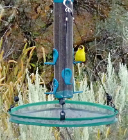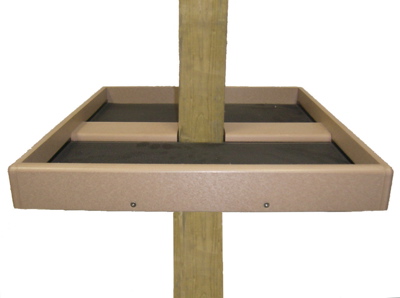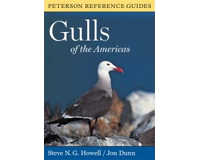-
Seed Trays Make Bird Feeding Better
Good reasons for adding seed trays to your bird feeders:
Ground mess – spilled seed not only looks unsightly, it creates weeds…yuk!
Disease – When wasted seed sits on the ground, it also becomes moldy and nasty. Hungry ground feeding birds like sparrows and others will forage through nasty seeds. This makes them ill with respiratory problems and diseases are spread quickly among the bird population in your yard. Seed trays prevent the spilled seed from reaching the ground in the first place.
You can attract different species and actually see more birds as many seed trays also act as a platform, allowing additional feeding space. Birds who never perch at your feeder may likely drop by and land on the platform for a snack. So seed trays can also act as a whole new feeder below your existing hopper or tube style bird feeder.
Whether it’s a hanging, or pole-mounted feeder, seed trays are available to fit it. The SeedHoop pictured above is an adjustable seed tray that works with any tube feeder. It’s also available with in a 30-inch diameter for larger bird feeders. By saving wasted seed, you’ll save money too in the long run
-
Innovative Seed Tray for Posts
Offer your feathered friends more space to feed…
Invite new birds who may not even perch at your feeder with a seed tray. They’re excellent for eliminating ground mess, while saving your birdseed and money. Any type of food, from suet and seed, to mealworms and fruit treats may be fed on this type of platform.
This recycled seed tray is made from poly lumber, and is guaranteed to never crack, split, or fade. The innovative design allows you to place it below a hopper style, or other bird feeder that’s mounted on a 4×4 post. Removable trays make it simple to clean this great seed tray.
Recycled plastics help to keep containers and milk jugs out of landfills, and they’re less likely to aid in the spread of diseases as they are non-porous. This makes them easy to clean too.
-
Bird Field Guides-Handy at Home and Away
At home a handy bird book sits on the breakfast room table along with a small pair of binoculars. When time permits, which seems scare, or when the occasional rare bird visits the yard, I’ll pick up the field guide to try and identify the new species.
This week however, unexpected travels took me to a hospital that sits across the street from the bay in South Jersey. On one of many breaks from the Intensive care Room, I walked down to the bay to watch the birds-mostly sea gulls. Living in Georgia for the past 25 years or so, I don’t get to see the shore birds anymore, except for the annual beach vacation after Labor Day. Bird Field Guides would have allowed me to identify the different species of shore birds I was witnessing this sunny day. It would have likely taken my mind off of the sad situation at hand as well.



 Offer your feathered friends more space to feed…
Offer your feathered friends more space to feed… At home a handy bird book sits on the breakfast room table along with a small pair of binoculars. When time permits, which seems scare, or when the occasional rare bird visits the yard, I’ll pick up the field guide to try and identify the new species.
At home a handy bird book sits on the breakfast room table along with a small pair of binoculars. When time permits, which seems scare, or when the occasional rare bird visits the yard, I’ll pick up the field guide to try and identify the new species.